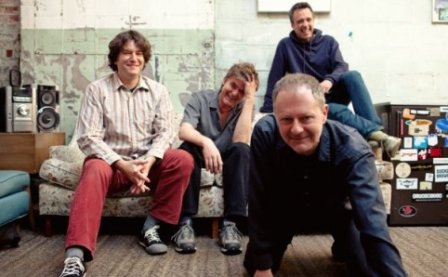By and large, this is no longer the so-called “indie-rock nostalgia circuit,” not after Mission of Burma’s post-reunion recorded output almost quadruples that of their formal years. In a time when everyone’s favorite band from whenever in the past three decades has decided to step up and “work” again, Mission of Burma have not only been doing the “work,” but have also been working at the “work,” making each album since their 2004 reunion album OnOffOn an example of both their sound and their aesthetic. Despite how one may feel about the quality of their most recent material, it goes without saying that it is admirable (if not impressive) that MoB continue to make their albums in these times. There seems to be no stopping them: not age, not guitarist Roger Miller’s tinnitus (which contributed to their initial split), and not the fear of relevance/irrevelance in the modern age.
Unsound exhibits the band in their usual form of “experimentation,” sharing songwriting duties between Miller, bassist Clint Conley, and drummer Peter Prescott. Miller wrote songs on bass rather than guitar (“ADD in Unison,” album closer “Opener”); Bob Weston adds both tape loops and trumpet (which provides one of album’s best sonic-glory moments on “ADD in Unison”); and “Dust Devil” is apparently the product of an acoustic guitar improvisation, but in no way does it sound like an acoustic-minded song.
One thing that can be said (taken either critically or as a compliment) is that, in any form of experimentation MoB undertakes, they still sound like themselves. Not in self-parody by any means; I would even argue that “7’s,” a song opened in guitar tremolo, could go toe-to-toe against the similarly introduced “Secrets” from their much-lauded Vs. Likewise, I’d put “Second Television” up against anything in their history; it’s a strong song of changing forms and dynamics, from melodic to urgent all within its under-four-minute span. If anything, the type of experimenting they do shows what forms they take to reach similar grounds, how their creation aesthetic works, and what makes this kind of post-punk thing appealing to both the “art critic” and the person looking for something loud to sing along with.
I feel compelled to touch upon one song in particular, “This Is Hi-Fi,” a song that calls technical advancement into question. It’s a creation of after-effects possible with current and digital technology, and it uses these effects to demand answers of the “tiny ears, tiny speakers” that have dominated our interactions with music. Indeed, my first listen to Unsound was on laptop speakers, and “This Is Hi-Fi” caught me red-handed. Even as I leave my house, I find myself around people listening to music primarily alone, on little white earbuds. If it’s a collective effort, the music comes played off of a smartphone, and the surrounding participants aren’t always the most willing — say, a crowded bus for example. When all the effects are cut out, taken down, and the complications of the song give way to a unified belting of “THIS IS HI-FI!” by the band, the song reaffirms that a visceral experience is what brings us to sound and through music. Appropriately, it ends with all parts played through the “telephone” effect, the distance regained, the sound reminiscent of being played off a speaker the size of my eyeball. The ending works to prove their point, but part of me wishes they would have stayed away from the ending effect altogether and just played out the song as it was. Maybe this can be seen as a testament to the effectiveness of their intent, but after a few listens, I find myself wanting to do away with the lesson and experience the song as it is. In any case, “This Is Hi-Fi” is good reminder of how technology hasn’t necessarily enhanced our relationship with music.
For all the pressure placed on the average 20-something from the media’s idea of success, the case of MoB and Unsound shows that if you want to uphold your ideals over immediate gratification, it’s possible to continue at a better time. (In the documentary “(This Is Not A) Photograph” it’s mentioned that the band turned down opening for Rush before their breakup; I think it’s safe to assume that Rush won’t be asking again anytime soon.) While acting more like a well-constructed argument than a manifesto, Unsound shows that you can still fight into the later years.
More about: Mission of Burma




